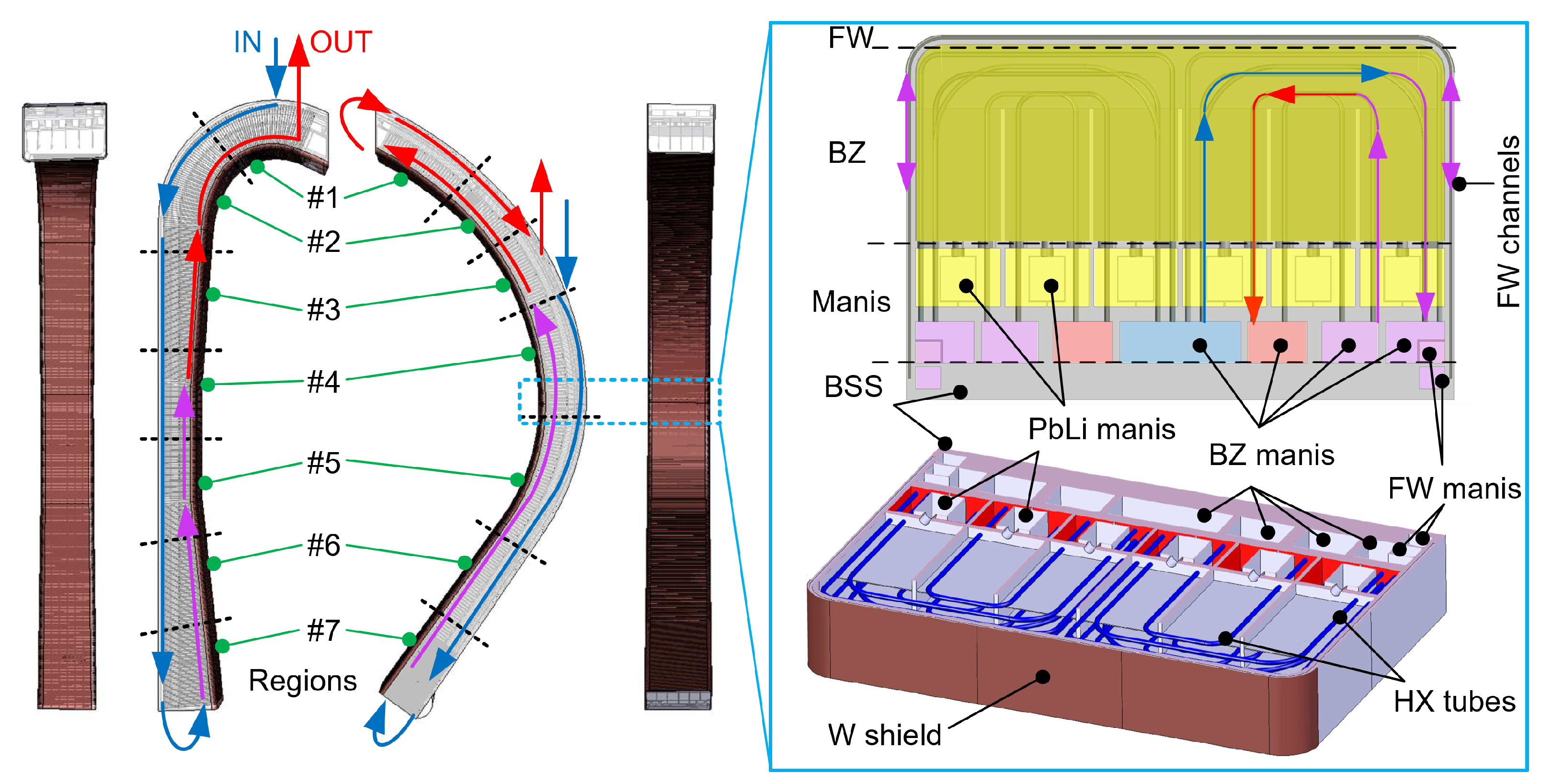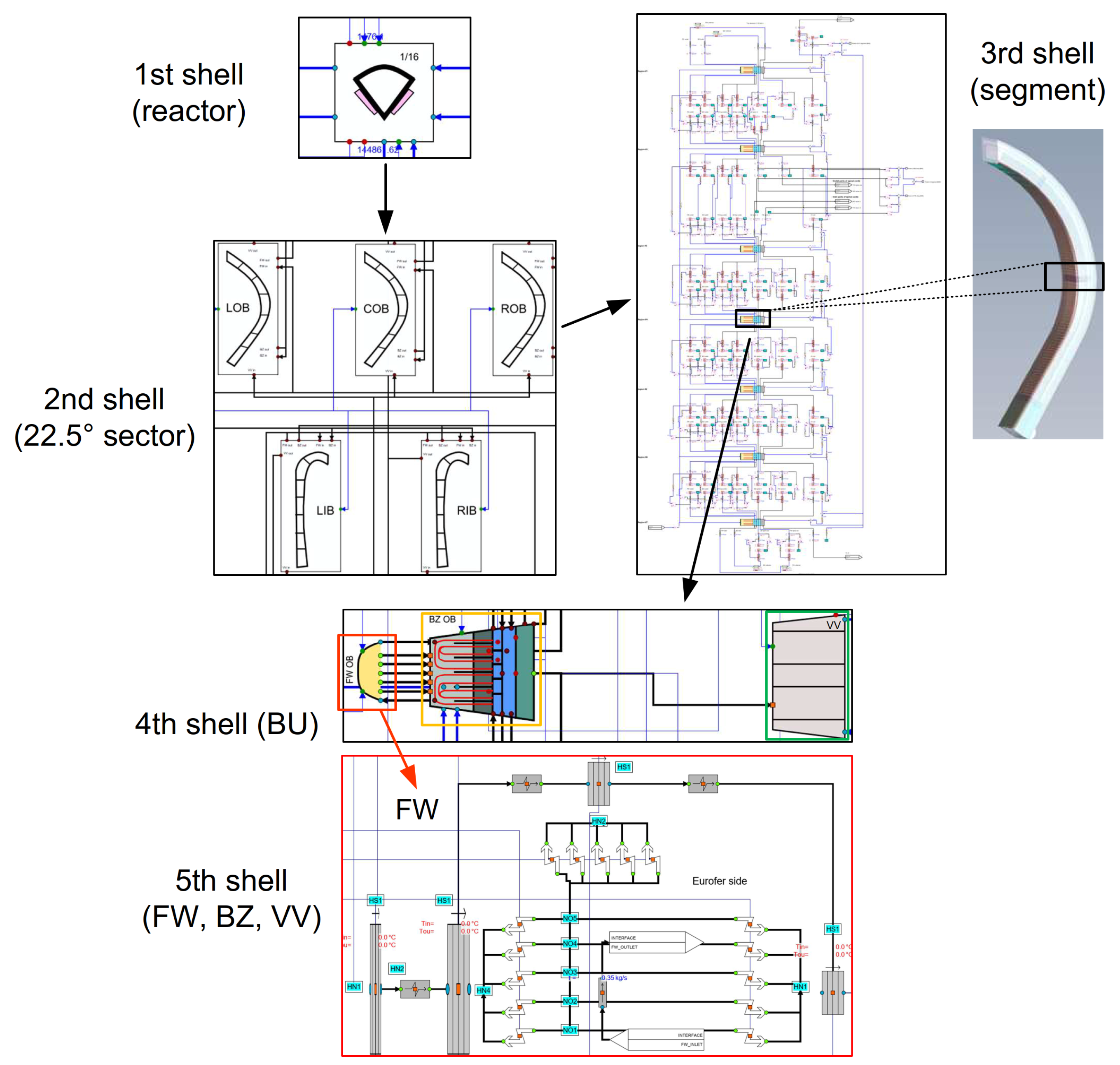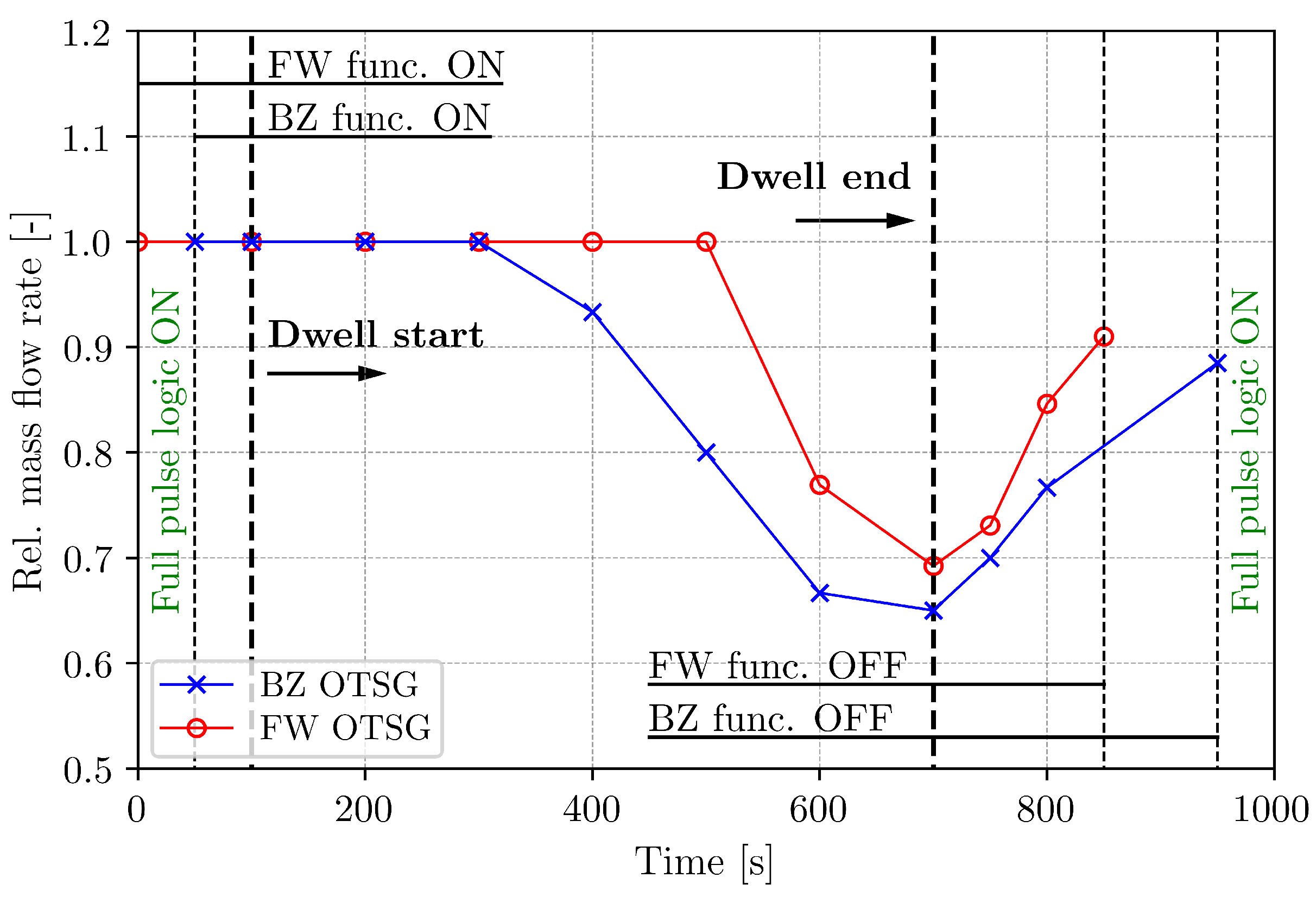Model Development and Transient Analysis of the WCLL BB BOP DEMO Configuration Using the Apros System Code
Abstract
:1. Introduction
2. WCLL Small ESS BOP Configuration
2.1. Primary Heat Transfer System
2.2. Power Conversion System
2.3. Small Energy Storage System
3. Apros Model
3.1. Primary Heat Transfer System
3.2. Power Conversion System
3.3. Small Energy Storage System
3.4. Logics
4. Results
4.1. Primary System Behaviour
4.2. Secondary System Behaviour
4.3. Small ESS Behaviour
5. Synopsis
6. Outlook
Author Contributions
Funding
Acknowledgments
Conflicts of Interest
Abbreviations
| Apros | Advanced Process Simulation | IB | Inboard |
| AUXB | Auxiliary Boiler | IHTS | Intermediate Heat Transfer System |
| BB | Breeding Blanket | LIB | Left Inboard |
| BC | Boundary Condition | LOB | Left Outboard |
| BOP | Balance Of Plant | LP | Low-pressure |
| BSS | Back Support Structure | MS | Moisture Separator |
| BU | Breeding Unit | MSEH | Molten Salt Electrical Heater |
| BZ | Breeding Zone | MSL | Main Steam Line |
| CL | Cold leg | MSSG | Molten Salt Steam Generator |
| COB | Central Outboard | OB | Outboard |
| CV | Control Valve | OTSG | Once-Through Steam Generator |
| DC | Downcomer | PCS | Power Conversion System |
| DEA | Deaerator | PHTS | Primary Heat Transfer System |
| DEMO | Demonstration Power Plant | RH | Reheater |
| DIV-CAS | Divertor Casette | RIB | Right Inboard |
| DIV-PFU | Divertor Plasma Facing Unit | ROB | Right Outboard |
| DL | Dump Line | SCL | Simantics Constraint Language |
| ESS | Energy Storage System | SG | Steam Generator |
| FH | Feedheater | ST | Steam Turbine |
| FW | First Wall | TH | Thermalhydraulic |
| FWHX | Feedwater Heat Exchanger | UC | User Component |
| HCPB | Helium-Cooled Pebble Bed | VV | Vacuum Vessel |
| HL | Hot leg | WCLL | Water-Cooled Lithium-Lead |
| HP | High-pressure | ||
| Variables | |||
| MSL pressure loss | MSEH power | ||
| Cycle efficiency | MSSG power | ||
| Overall efficiency | Nominal power | ||
| Heat transfer area | SG power | ||
| Gravitational/weight force | Steam quality in MSL | ||
| Collector water level | t | Time | |
| Waterport elevation | Cycle length | ||
| BZ loop primary flow rate | Cold salt tank temperature | ||
| Discharge/charge salt flow rate | Hot leg temperature | ||
| FW loop primary flow rate | Hot salt tank temperature | ||
| SG steam flow rate | SG steam temperature | ||
| Hot leg pressure | Saturation temp. in HL | ||
| SG steam pressure | Primary side SG temperature | ||
| BB power | Max. water temperature in PHTS | ||
| DIV power | Gross power | ||
| VV power | Pumping power of the PCS | ||
| Fusion power | Plant power |
References
- Hernández, F.; Pereslavtsev, P.; Kang, Q.; Norajitra, P.; Kiss, B.; Nádasi, G.; Bitz, O. A new HCPB breeding blanket for the EU DEMO: Evolution, rationale and preliminary performances. Fusion Eng. Des. 2017, 124, 882–886. [Google Scholar] [CrossRef]
- Nevo, A.D.; Arena, P.; Caruso, G.; Chiovaro, P.; Maio, P.; Eboli, M.; Edemetti, F.; Forgione, N.; Forte, R.; Froio, A.; et al. Recent progress in developing a feasible and integrated conceptual design of the WCLL BB in EUROfusion project. Fusion Eng. Des. 2019, 146, 1805–1809. [Google Scholar] [CrossRef] [Green Version]
- Barucca, L.; Bubelis, E.; Ciattaglia, S.; D’Alessandro, A.; Nevo, A.D.; Giannetti, F.; Hering, W.; Lorusso, P.; Martelli, E.; Moscato, I.; et al. Pre-conceptual design of the EU DEMO balance of plant systems: Objectives and challenges. Fusion Eng. Des. 2021, 169, 112504. [Google Scholar] [CrossRef]
- Szogradi, M.; Norrman, S.; Bubelis, E. Dynamic modelling of the helium-cooled DEMO fusion power plant with an auxiliary boiler in Apros. Fusion Eng. Des. 2020, 160, 111970. [Google Scholar] [CrossRef]
- Official Apros Website. Available online: https://www.apros.fi/ (accessed on 25 May 2021).
- Sohal, M.S.; Ebner, M.A.; Sabharwall, P.; Sharpe, P.B. Engineering Database of Liquid Salt Thermophysical and Thermochemical Properties; INL/EXT-10-18297 Rev. 1; Idaho National Laboratory: Idaho Falls, ID, USA, 2013; p. 24. [Google Scholar]
- Janky, F.; Fable, E.; Treutterer, W.; Zohm, H. Simulation of burn control for DEMO using ASTRA coupled with Simulink. Fusion Eng. Des. 2017, 123, 555–558. [Google Scholar] [CrossRef]
- Wouter, X.B.D.; Richard, P.A.; David, C.; Sergey, V.; Sven, W. Presentation of the New SOLPS-ITER Code Package for Tokamak Plasma Edge Modelling. Plasma Fusion Res. 2016, 11, 1403102. [Google Scholar]
- Moscheni, M.; Carr, M.; Dulla, S.; Maviglia, F.; Meakins, A.; Nallo, G.F.; Subba, F.; Zanino, R. Radiative heat load distribution on the EU-DEMO first wall due to mitigated disruptions. Nucl. Mater. Energy 2020, 25, 100824. [Google Scholar] [CrossRef]
- Moro, F.; Colangeli, A.; Nevo, A.D.; Flammini, D.; Mariano, G.; Martelli, E.; Mozzillo, R.; Noce, S.; Villari, R. Nuclear analysis of the Water cooled lithium lead DEMO reactor. Fusion Eng. Des. 2020, 160, 111833. [Google Scholar] [CrossRef]
- Moro, F.; Arena, P.; Catanzaro, I.; Colangeli, A.; Nevo, A.D.; Flammini, D.; Fonnesu, N.; Forte, R.; Imbriani, V.; Mariano, G.; et al. Nuclear performances of the water-cooled lithium lead DEMO reactor: Neutronic analysis on a fully heterogeneous model. Fusion Eng. Des. 2021, 168, 112514. [Google Scholar] [CrossRef]
- American Society of Mechanical Engineers. ASME Boiler & Pressure Vessel Code, Section III-Rules for Construction of Nuclear Facility Components, Division 1-Subsection NB for Class 1 Components; ASME: New York, NY, USA, 2019. [Google Scholar]














| Param. | [MWth] | [MWth] | / [kg/s] * | [bar] | |
|---|---|---|---|---|---|
| Phase | |||||
| Pulse | 2019.8 | 337.0 | 2 × 3830.0/2 × 1124.0 | 155.0 | |
| Dwell | 20.2 | 3.37 | |||
| Param. | [MWth] | [bar] | [°C] | [m2] | [kg/s] | |
|---|---|---|---|---|---|---|
| UC | ||||||
| BZ OTSG | 742 | 70.0 | 320–330 | 4904 | 3830 | |
| FW OTSG | 220 | 1388 | 1137 | |||
| Phase | Pulse | Dwell | |
|---|---|---|---|
| Param. | |||
| [MWe] | ∼41.2 | ∼15.7 | |
| [MWth] | 14.21 | 270.11 | |
| [°C] | 330.0 | 330.0 | |
| [°C] | 282.4 | 282.4 | |
| [kg/s] | 189.9 | 3590.0 | |
| [kg/s] | 522.1 | 210.9 | |
Publisher’s Note: MDPI stays neutral with regard to jurisdictional claims in published maps and institutional affiliations. |
© 2021 by the authors. Licensee MDPI, Basel, Switzerland. This article is an open access article distributed under the terms and conditions of the Creative Commons Attribution (CC BY) license (https://creativecommons.org/licenses/by/4.0/).
Share and Cite
Szogradi, M.; Norrman, S. Model Development and Transient Analysis of the WCLL BB BOP DEMO Configuration Using the Apros System Code. Energies 2021, 14, 5593. https://doi.org/10.3390/en14185593
Szogradi M, Norrman S. Model Development and Transient Analysis of the WCLL BB BOP DEMO Configuration Using the Apros System Code. Energies. 2021; 14(18):5593. https://doi.org/10.3390/en14185593
Chicago/Turabian StyleSzogradi, Marton, and Sixten Norrman. 2021. "Model Development and Transient Analysis of the WCLL BB BOP DEMO Configuration Using the Apros System Code" Energies 14, no. 18: 5593. https://doi.org/10.3390/en14185593





